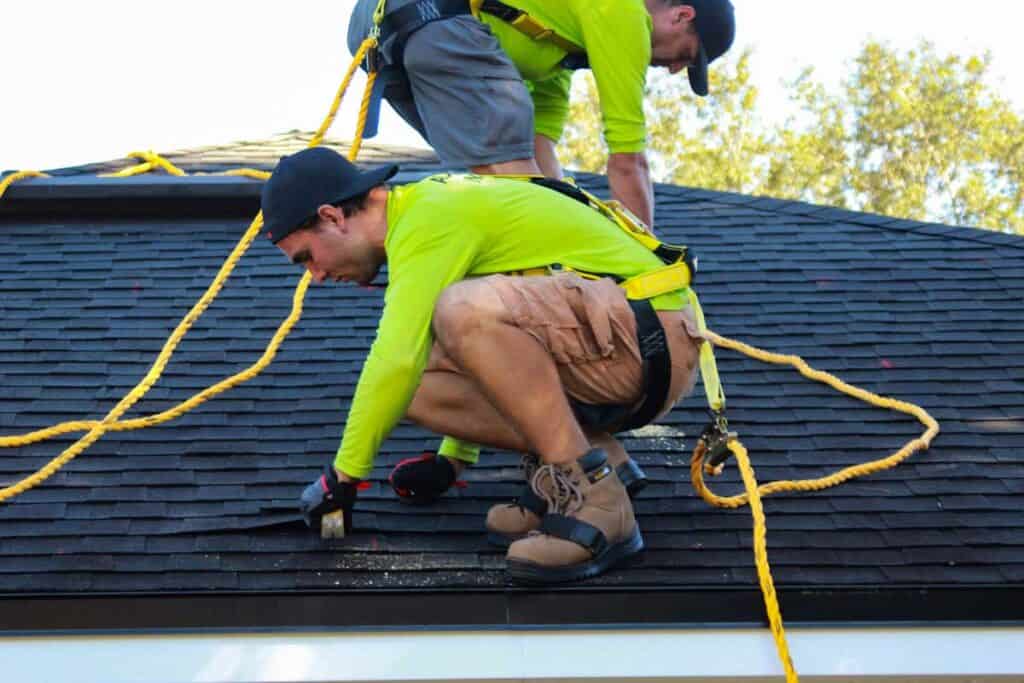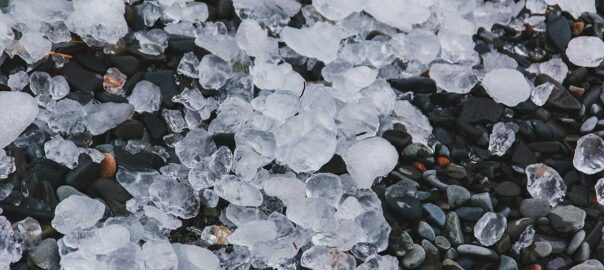When protecting your home, your roof is truly the MVP. It stands guard against rain, wind, snow, sun, and, of course, hail. If you live in a hail-prone area, you’re probably all too familiar with the anxiety accompanying a thunderstorm during hail season — wondering if today’s weather will leave your roof battered or even seriously damaged. This is a relatively common occurrence here on Colorado’s Front Range.
Here’s the thing: Not all roofs are created equal regarding hail resistance. Whether you’re replacing your roof after a storm or just looking to upgrade before the next one hits, the material you choose will significantly impact how well your roof stands up to hail. But how do you know the best roofing material for hail-prone areas?
This guide will compare the top roofing materials—asphalt shingles, metal, and tile—regarding their hail resistance and other essential factors. We’ll also discuss how to choose the right material based on where you live, plus the pros and cons of each material regarding extreme weather. Buckle up! We’re about to dive into the world of roofing materials in a way that’s informative, fun, and, dare we say, a little playful.
Hail 101: Why Does It Matter?
Before we get into the materials, let’s quickly talk about hail.
It’s one of Mother Nature’s more unpredictable challenges, especially during a hail storm. Hailstones can vary significantly, from tiny pea-sized pebbles to golf-ball-sized stones. And every once in a great while… our area gets hit by softball-sized monster hail stones that can cause massive damage.
According to the National Weather Service, hail causes more than $1 billion in property damage yearly in the U.S. alone. And it seems to be hailing more often because of the jet stream over the Colorado Front Range.
The severity of hail damage to your roof depends on several factors: the size of the hailstones, the hardness of the hailstones, the speed of the wind, the age of your roof, and the roofing material itself. This is why choosing and investing in hail-resistant roofing material can save homeowners from costly repairs after a hail storm. It is so vital in hail-prone areas. It could save you thousands of dollars in repairs and insurance claims.

So, let’s explore the three most common roofing materials and see how they fare for hail damage.
Asphalt Shingles: The Classic Go-To Option
Hail Resistance:
Asphalt shingles are one of the most popular roofing materials in the U.S., and for good reason. They’re affordable, widely available, and come in various styles. However, when it comes to hail, they’re not the strongest contender on the block. Standard asphalt shingles typically handle hail reasonably well, but hail damage is standard on older roofs because of the older shingle construction. The shingles may crack or bruise, leading to leaks or the need for repair.
Class 4 impact-resistant asphalt shingles are designed to resist hail and provide excellent protection. (the highest-rated level for impact resistance) can provide extra protection against hail, with some models even certified to withstand hailstones up to 2 inches in diameter, depending on the hardness of the stone.
If you live in a hail-prone area and want asphalt shingles, you should look for Class 4-rated shingles. They offer better protection against hail compared to standard shingles.
We ALSO want to share that some brands of Class 4 Shingles are better than others based on our professional opinion. We have seen it over and over where even though shingles are UL-rated Class 4 IR shingles – when they are placed right next to each other, some perform better than others. Contact us so that we can suggest the best shingles on the market. We like them so much that we are Certified Installers of several shingle manufacturers that we think are the best in the biz.
Shingle technologies have been changing over the last 10 years and are improving. We can help explain how.
Pros:
- Affordable: Asphalt shingles are one of the most cost-effective roofing materials.
- Variety of Styles: You can choose various colors, styles, and textures.
- Energy-Efficient Options: Many asphalt shingles are designed to reflect heat, helping to keep your home cooler in the summer.
- More straightforward to Repair: Asphalt shingles are relatively easy and inexpensive to repair if you do have damage.
Cons:
- Hail Damage: Standard asphalt shingles aren’t the most durable in the face of hail. Especially if not rated Class 3 or Class 4 IR shingles, they can crack or dent with larger hailstones, mainly if the impact rating is low.
- Shorter Lifespan: Asphalt shingles typically last 15 to 20 years, depending on the quality and weather conditions. This is shorter than the lifespan of some materials, such as metal or tile.
- Environmental Impact: Asphalt shingles are also not the most eco-friendly roofing material, as they are made from petroleum products.
Best For:
- Homeowners on a budget who want decent hail protection.
- Areas with mild to moderate hail conditions still want some impact resistance.
Metal Roofing: The Durable, Long-Lasting Champion
Hail Resistance:
Metal roofing is an excellent choice if you live in a region with frequent hailstorms. Metal roofs are highly durable and can withstand hailstones as large as 2 inches or more without showing much damage. Many metal roofs are rated to resist impact from larger hailstones and strong winds. The smooth surface of metal roofing also prevents debris from settling, which can prevent further damage from future storms.
The great thing about metal roofing is that it’s available in different styles—standing seam, pro-panel, corrugated, or shingle-style metal—and various colors, so you don’t have to sacrifice aesthetics for strength.
Pros:
- Hail-Resistant: Metal roofs are excellent at withstanding hail and extreme weather conditions, including high winds and heavy rain.
- Longevity: Metal roofs last 40 to 70 years, making them a long-term investment.
- Energy-Efficient: If insulated correctly, metal reflects sunlight, helping reduce energy costs and keeping homes cooler in summer.
- Minimal Maintenance: Once installed, metal roofs require little upkeep and are resistant to rust and corrosion.
Cons:
- Upfront CostWhile metal roofs last longer, they have a higher upfront cost than other types of roofs, such as asphalt shingles or sometimes tile.
- Noise: During heavy rain or hailstorms, metal roofs can be noisy. However, this can be mitigated by adding insulation or additional roofing underlayment.
- Denting: Though hail-resistant, large hailstones or sharp impacts may still cause dents or cosmetic damage to some metal roofing options.
Best For:
- Homeowners in hail-prone areas who want durability and longevity.
- Those willing to invest more upfront for a long-term solution.
Tile Roofing: The Classic, Beautiful, and Strong Option
Hail Resistance:
Tile roofs, especially those made from clay or concrete, are another excellent option for hail-prone areas. They are known for their beauty and durability. However, when it comes to hail resistance, tile roofs are tricky. They can withstand large hailstones, and their thick structure means they won’t easily crack or dent from more minor hail.The downside is that tiles can be more fragile than metal roofs. The tiles may crack or break if hailstones are huge, leading to costly repairs. However, since the underlying roofing structure (underlayment) is still intact, the damage won’t necessarily affect the roof’s overall waterproofing ability.
Pros:
- Very Durable: Tile roofs are incredibly long-lasting and can endure extreme weather conditions.
- Hail-Resistant: Especially clay and concrete tiles, which are built to withstand significant impacts.
- Energy-Efficient: Tile roofs offer excellent insulation, keeping your home cooler in the summer and warmer in the winter.
- Aesthetic Appeal: Tile roofing is often more aesthetically pleasing, offering a classic Mediterranean or Spanish-style look.
Cons:
- Fragile: While tiles are durable, they can crack under impact from large hailstones or heavy debris.
- Heavy: Tile roofs are much heavier than asphalt or metal, so your home’s structure may need to be reinforced before installation.
- Cost: Depending on the type of tile chosen, tile roofs are more expensive than asphalt shingles and may cost more to install than metal roofs.
- Expensive Repairs: While the underlayment may remain intact, tile replacement is costly and time-consuming.
Best For:
- Homeowners are looking for a durable, aesthetic roof that will withstand hailstorms.
- Those who live in hail-prone areas with frequent or severe storms.

How to Choose the Right Roofing Material for Your Area
Choosing the best roofing material for your home depends heavily on your geographic location and the weather your roof will face. Here’s a quick guide to help you choose the right roofing material for hail-prone areas, focusing on their ability to withstand hail impact.
Consider Your Climate:
- Hail Frequency: If you live in a hail belt area (think Colorado, Nebraska, Kansas, or Texas), invest in a material that can withstand hailstones as more sive or ficant than half ball.
- Wind Conditions: High winds often bring hail, so ensure your roofing material can handle gusts. Metal and tile roofs tend to fare better in high winds, and the newer shingle technologies are improving.
- Temperature Extremes: Extreme heat and cold can crack or damage asphalt shingles and tiles. Metal and tile are better equipped to handle these extreme weather shifts.
Budget vs. Durability:
- If you’re on a budget, asphalt shingles (particularly Class 4 impact-rated shingles) can provide good protection at a lower cost.
- Metal or tile roofing may be worth the investment if you want something that lasts and offers excellent hail resistance.

Other Popular Questions We Receive Related to Roofing Products and Synthetic Roofing Materials.
Q: What is a hail-resistant roof?
A hail-resistant roof is designed to withstand the impact of hailstones without sustaining significant damage. It often has a higher impact rating, such as a class 4 rating, which indicates its effectiveness in resisting hail damage.
Q: What is the best roof for hail-prone areas?
A: The best roofs for hail-prone areas include impact-resistant shingles, rubber, and metal roofs. These materials are known for their durability and resistance to hail damage, making them ideal for protecting your roof during hail storms.
Q: How can I protect my roof from hail?
A: Consider installing hail-resistant roofing materials like class 4 impact-resistant shingles or metal roofing to protect your roof from hail. Regular maintenance and inspections can also help identify and address vulnerabilities before a storm occurs.
Q: What is the difference between hail-proof and hail-resistant roofs?
A: A hail-resistant roof is designed to minimize damage from hail, while a hail-proof roof implies a higher level of protection that can withstand severe hail impacts without any damage. However, it’s important to note that no roof is entirely hail-proof.
Q: What type of roof is best for hail storms?
A: The best roofing material for hail storms includes options with a class 4 hail rating, such as impact-resistant shingles, rubber roofs, and slate or tile roofs. These materials are specifically engineered to withstand large hail and help prevent roof damage.
Q: How does hail damage affect roof repair costs?
A: Hail damage can lead to significant roof repair costs, depending on the severity of the damage and the type of roof you have. Roofing contractors often assess the extent of the damage to provide an accurate repair estimate, which can vary widely based on the roofing system and materials used.
Q: What is a class 4 hail rating?
A: A class 4 hail rating is the highest impact resistance rating for roofing materials. It indicates that the roofing can withstand impacts from hailstones up to 2 inches in diameter, equivalent to the effect of a steel ball dropped from a height of 20 feet.
Q: Are there any warranties available for hail-resistant roofs?
A: Yes, many manufacturers offer hail warranties for hail-resistant roofing materials. These warranties can provide coverage for repairs or replacements due to hail damage, but it’s essential to read the terms carefully to understand the coverage details.
Q: Can slate and tile roofs withstand hail?
A: Slate and tile roofs are known for their durability and can effectively withstand hail impacts. However, the performance can vary depending on the quality of the materials and installation, so choosing reputable roofing is essential.
Q: How can I choose the best roofing material for hail?
A: When choosing the best roofing material for hail, consider the impact resistance rating, durability, and maintenance requirements. Consulting with a knowledgeable roofing contractor can help you evaluate your options and select the best roof for hail-prone areas.

Conclusion: Roof Like a Pro
Choosing the right roof material for hail-prone areas is a big decision. It all comes down to balancing cost, durability, and aesthetic appeal.
Asphalt shingles are an excellent option for budget-conscious homeowners who want reasonable hail protection.
Metal roofs in some geographic regions can be a GREAT choice.
At Denny’s Roofing, as insurance companies often recommend durable roofing options, we specialize in helping homeowners navigate these decisions. If you’re unsure about the condition of your roof, we offer free roof inspections to help you make an informed decision. Our team of roofing experts will assess your roof and walk you through your options so you can make the best choice for your home and budget.
Ready to schedule your roof inspection? Call us at 970-275-4012 or email us at denny@dennysroofing.com. We’re here to help!

